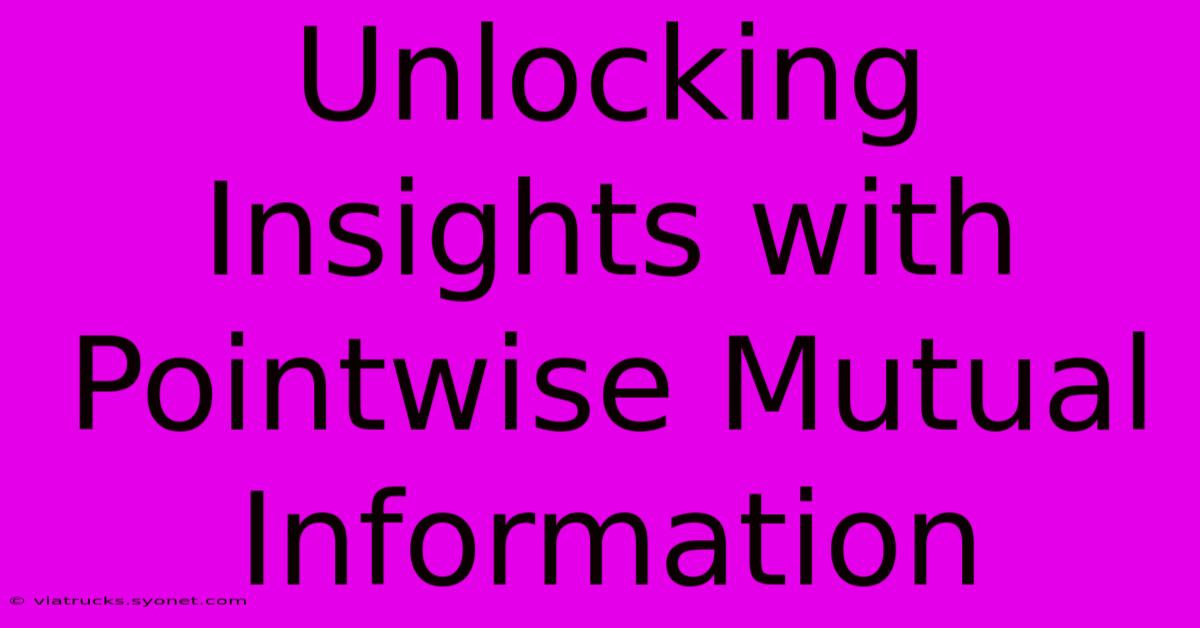Unlocking Insights With Pointwise Mutual Information

Table of Contents
Unlocking Insights with Pointwise Mutual Information
Pointwise Mutual Information (PMI) is a powerful statistical measure that quantifies the association between two events. It's particularly useful in natural language processing (NLP), information retrieval, and other fields dealing with large datasets where understanding relationships between variables is crucial. This article will delve into the concept of PMI, explaining its calculation, applications, and limitations.
Understanding Pointwise Mutual Information
PMI measures the extent to which the occurrence of one event surprises us given the occurrence of another event. A high PMI suggests a strong association, indicating that the presence of one event makes the other significantly more likely. Conversely, a low or negative PMI suggests a weak or inverse relationship.
The Formula: Deconstructing PMI
The formula for PMI is deceptively simple:
PMI(x, y) = log₂ [P(x, y) / (P(x) * P(y))]
Where:
- P(x, y): The joint probability of events x and y occurring together.
- P(x): The probability of event x occurring.
- P(y): The probability of event y occurring.
- log₂: The base-2 logarithm (used to express the result in bits).
Essentially, PMI compares the observed joint probability of two events to what we would expect if the events were independent. If the observed joint probability is much higher than the expected probability (based on independence), the PMI will be positive and large.
Interpreting PMI Values
- PMI > 0: Indicates a positive association between events x and y. They tend to co-occur more often than expected by chance.
- PMI = 0: Indicates no association. The events are independent.
- PMI < 0: Indicates a negative association (or inverse relationship). The events occur together less often than expected by chance.
Applications of Pointwise Mutual Information
PMI's versatility makes it applicable across various domains:
1. Natural Language Processing (NLP):
- Collocation Extraction: Identifying words that frequently appear together (e.g., "strong coffee," "artificial intelligence"). High PMI values help identify meaningful phrases and collocations.
- Word Sense Disambiguation: Determining the correct meaning of a word based on its context. PMI can help resolve ambiguities by considering the associations between a word and its surrounding words.
- Topic Modeling: Identifying underlying themes in text corpora. PMI can help determine the strength of association between words and topics.
2. Information Retrieval:
- Query Expansion: Enhancing search queries by adding related terms. PMI can identify terms strongly associated with the original query terms, improving search results.
- Document Similarity: Measuring the similarity between documents based on the co-occurrence of keywords.
3. Bioinformatics:
- Gene Co-expression Analysis: Identifying genes that are likely to be co-regulated or functionally related.
4. Recommender Systems:
- Identifying item associations: PMI can help determine which items are frequently purchased or rated together, useful for suggesting relevant products or services.
Limitations of Pointwise Mutual Information
Despite its usefulness, PMI has limitations:
- Sensitivity to Low Probabilities: PMI is sensitive to low probabilities. Even a small number of co-occurrences can inflate PMI if the individual probabilities are low. This is often addressed using Positive Pointwise Mutual Information (PPMI), which sets negative PMI values to zero.
- Data Sparsity: In large datasets with many events, many pairs of events might have zero or very low co-occurrences, leading to unreliable PMI estimates. Smoothing techniques can mitigate this issue.
- Doesn't Capture Complex Relationships: PMI primarily captures pairwise relationships. It doesn't directly model higher-order interactions between multiple events.
Conclusion: Harnessing the Power of PMI
Pointwise Mutual Information offers a valuable tool for uncovering hidden relationships within data. By understanding its calculation, applications, and limitations, researchers and practitioners can leverage its power to gain deeper insights from their datasets, particularly in fields like NLP and information retrieval. Addressing the limitations through techniques like PPMI and smoothing ensures more robust and reliable results. Remember to consider the context and limitations of PMI when interpreting results and drawing conclusions.

Thank you for visiting our website wich cover about Unlocking Insights With Pointwise Mutual Information. We hope the information provided has been useful to you. Feel free to contact us if you have any questions or need further assistance. See you next time and dont miss to bookmark.
Featured Posts
-
Never A Dull Moment Discover The Girl With The Dragon Tattoo Book
Feb 09, 2025
-
Red White Blue Flag More Than Just A Decoration
Feb 09, 2025
-
The Future Of Power Examining Israel And Turkeys Democratic Paths
Feb 09, 2025
-
West Islip New York Your Dream Home Awaits
Feb 09, 2025
-
Nice Lens Compositions Officielles
Feb 09, 2025
